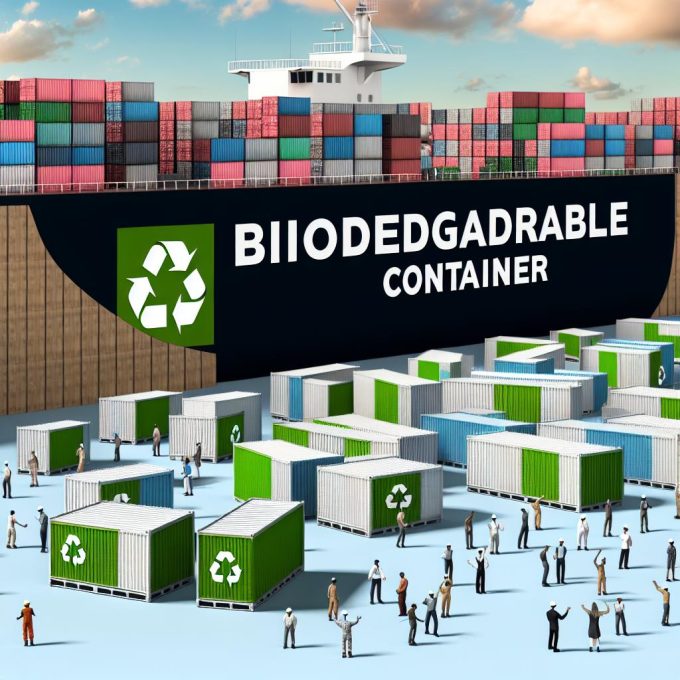Introduction to Biodegradable Containers
The evolution of sustainable shipping solutions has gained significant momentum in recent years. Among various innovations, biodegradable containers have emerged as a promising alternative to traditional materials. These containers are designed to break down naturally in the environment, reducing the ecological footprint associated with shipping and packaging. Their development is part of a broader movement towards sustainability that many industries are embracing as they aim to lessen their impact on the planet.
Materials Used in Biodegradable Containers
Biodegradable containers are typically crafted from natural materials such as plant fibers, starch, and cellulose-based polymers. These materials are not only renewable but also possess qualities that allow them to decompose naturally over time, minimizing waste accumulation and environmental pollution. This shift towards using natural materials is a crucial step in addressing the mounting problem of waste management and pollution.
Plant Fibers
Plant fibers, such as those derived from bamboo or sugarcane, are commonly used due to their strength and sustainability. These fibers lend themselves well to the production of sturdy containers that can withstand the demands of shipping. The resilience of plant fibers makes them an ideal choice for packaging that requires durability while ensuring eco-friendliness. Additionally, the cultivation of these plants can often be done with minimal environmental impact, further enhancing their sustainability profile.
Starch-Based Polymers
Starch-based polymers, derived from crops like corn and potatoes, are increasingly utilized in making biodegradable packaging. These polymers offer versatility in container production while ensuring that the end products remain environmentally friendly. Starch-based polymers have the added advantage of being adaptable in terms of design and functionality, allowing manufacturers to create a range of packaging solutions tailored to specific needs. As a result, they are becoming a popular choice for companies looking to reduce their carbon footprint.
Cellulose-Based Polymers
Cellulose-based polymers are another option, providing a biodegradable alternative that can be sourced from wood pulp or cotton. These materials contribute to the reduction of reliance on petroleum-based plastics. One of the major benefits of cellulose is that it is abundant and relatively easy to process, making it a cost-effective option for biodegradable packaging. By using cellulose-based materials, companies can help preserve natural resources and promote sustainable practices.
Benefits of Using Biodegradable Containers
Adopting biodegradable containers offers several benefits, both environmentally and economically. One of the primary advantages is the reduction of plastic pollution. Traditional shipping containers, often composed of plastic, take hundreds of years to decompose and can harm marine and terrestrial ecosystems. In contrast, biodegradable containers break down more rapidly and safely. This rapid degradation helps prevent the buildup of waste in landfills and reduces the risk of environmental contamination.
Another important benefit is the conservation of resources. By relying on renewable materials, the production of biodegradable containers helps reduce the demand for fossil fuels, which are typically required in the production of conventional plastics. This conservation is vital in the fight against climate change, as it helps to lower carbon emissions and decrease overall energy consumption.
Waste Management Advantages
Biodegradable containers can significantly improve waste management practices. They can be composted along with other organic waste, turning into valuable compost that can enrich soil health and reduce landfill usage. Composting biodegradable materials is a practical solution for managing waste sustainably, as it transforms waste into a resource that can benefit agricultural practices and contribute to a circular economy.
Challenges and Considerations
Despite their benefits, biodegradable containers also pose certain challenges. The degradation process can vary based on environmental conditions, and sometimes specific facilities are required to ensure proper decomposition. Factors such as temperature, humidity, and microbial activity can influence how quickly these materials break down, which can complicate disposal processes.
Furthermore, the current cost of production for biodegradable alternatives remains high compared to traditional materials, although this is expected to decrease as technology and infrastructure improve. Economies of scale, advances in manufacturing processes, and increased demand for sustainable packaging could help drive down costs, making biodegradable containers more accessible and widespread.
Future Prospects
The future of biodegradable containers looks promising as research and development continue to advance. Innovations such as nanotechnology and bio-engineering are paving the way for even more effective and efficient biodegradable materials. These advancements will likely contribute to a more widespread adoption of sustainable packaging solutions in shipping industries worldwide.
With continuous research, it is anticipated that biodegradable containers will become more robust, affordable, and efficient, making them a staple in the packaging industry. The growing emphasis on ecological responsibility among consumers and companies alike will further propel the adoption of these eco-friendly solutions.
Conclusion
In summary, biodegradable containers represent a key component of sustainable shipping. By leveraging materials that are renewable and eco-friendly, they offer practical benefits while addressing pressing environmental concerns. As the industry evolves, these containers will likely play a pivotal role in reshaping the future of shipping and packaging.
For those interested in exploring more about this topic, several organizations and research institutes focus on sustainability can provide additional insights. Engaging with these resources can deepen one’s understanding of the complexities and potential of biodegradable technologies, fostering an informed transition towards greener practices in shipping and packaging. As more stakeholders commit to sustainability, the incorporation of biodegradable containers will likely be integral to achieving global environmental goals.

